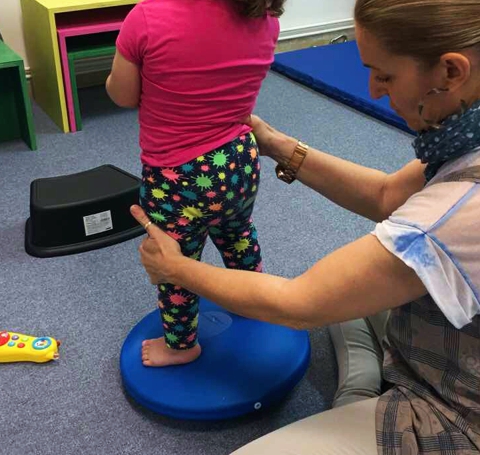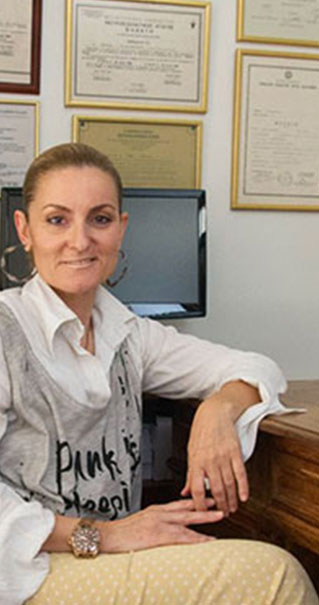Cerebral palsy is one of the most common relative or acquaintance neurological impairments. It refers to child’s brain and can be expressed by kinetics or/and mental deficits. The term cerebral palsy is used to describe a group of syndromes with a predominantly kinetic disorder due to a pre-existing impairment or disorder in the developing, immature brain, but often with a changing course. In this group is included static encephalopathy of the first years of life, and not degenerative diseases or spinal cord injuries without brain’s participation.[6,7,8,10]
Cerebral palsy causes kinetic dysfunction (motor and posture) due to muscle tone disorder. Although that brain lesion is stable or there is no recrudescence it is presented a pathological neurodevelopment. In cerebral palsy there is an impact in brain’s developmental procedure∙ on one hand there is a default neurodevelopment but at the same time there is brain dysfunction caused by the lesion. Cerebral palsy is often accompanied by other disorders when the lesion is presented in other than the kinetic centers. In these cases mental retardation and epilepsy can be presented as well as sensory integration, learning, perceptual and speech deficits.[1,3,7,9]
Psychomotor development refers to the development of gross and fine motor. From birth, psychomotor development tends to show multiple varieties in growth procedure. This procedure is composed to a developmental scale which is the average of normal infants. In real life, there are many children that appear deviations from the developmental scale in some psychomotor milestones, and this is not necessary a proof of pathology. Although the greater the deviation is from normal developmental scale the probability of abnormal behavior increases.[2,3,10]
The below board represents the normal and extreme age value of the most significant psychomotor stages, in which, extreme ages are very useful information because they signify the conventional limits of normal.
Psychomotor development schedule up to the age of two years.
|
Motor achievement |
Achievement age (months) |
|
|
Normal-usual age |
Extreme* |
|
|
Head control in sitting position |
3 |
4 |
|
keeps a rattle |
3 |
5 |
|
Reaches his/her hand to grasp an object |
3 |
5 |
|
Roll from prone to supine position |
3 |
|
|
Transfer objects from one hand to the other |
6 |
8 |
|
Sits stable without support |
6 |
8 |
|
Grasps an object with his/her thumb and index fingers |
9-10 |
14 |
|
Walks without help |
12-13 |
15 |
|
He/she can built a tower with 2 cubes |
14-15 |
20 |
|
Climb on stairs, holding the rails |
16-17 |
22 |
|
He/she can built a tower with 3-4 cubes |
18-20 |
25 |
|
Runs quite stable |
24-26 |
28 |
|
Kicks a ball |
20-22 |
24 |
|
He/she can built a tower with 6-7 cubes |
24-26 |
40 |
*the age in which the 90% of children acquires the specific ability (based on the data from the Denver Development Test)[4,10]
In psychomotor evaluation there are some criteria that require specific attention. In most cases parents tend to over evaluate the motor skills of their children or they are unable to remember the exact date in which a motor milestone has been achieved, so any information received from a parent regarding the medical history of a child needs to be checked and evaluated accordingly. In addition, big importance lies not only in achieving a motor skill but also in the quality and maturity of it. As an example of that, it indicates a different motor skill level the ability of a toddler to sit supported or independently or even if the kid lies back or forward after a couple of seconds sitting.[3,5,10]
The cooperation of a child is under evaluation as well. The ability of him/her to either follow or not therapist’s instructions needs to be taken into account while considering its motor skills level because in lack of cooperation the child’s abilities could be undervalued. Of great importance is also the fact that all the systems (mental, perceptional, motor, and psychological) are essential to be evaluated throughout child’s life. [11,12]
Clinical evaluation
The clinical evaluation of a child mainly focuses on neurological functions. More specifically:
- Somatometric measures ( head perimeter etc)
- Morphological features which imply genetic or chromosomic syndrome
- Skin testing for any features that accompany neurodegenerative syndromes or other disorders
- Check for hepatosplenomegaly or lymphadenopathy that is a symptom associated with metabolic diseases
- Eye fundus audit for signs of degenerative diseases, congenital infections, intracranial pressure etc
Observation of spontaneous functionality
Valuable information is elicited by careful observation of spontaneous kinetic action of the child, especially at his/her early years. The way that mother holds or carrying the child is very important from therapeutic view. Is also important to observe the way that the child plays or grasps toys and whether one side is more functional from the other.[10]
In older children the detailed recording and detailed observation of the child and its functional action can identify any motor problems and confirm, clarify and substantiate exactly the nature of the kinetic problem.[5,7]
Muscle tone and muscle power assessment
In infants with cerebral palsy, where injury is related to the upper motor neuron (the entire nerve pathway from the cerebral cortex to the kinetic cells of the anterior horns of the spinal cord), the muscle strength is normal or slightly reduced. The finding of significant muscle weakness suggests damage to the lower motor neuron (the entire nerve pathway from the kinetic stem cells of the spinal cord to the muscle fibers). Such muscular weaknesses exhibit lesions such as spinal muscular atrophy, peripheral neuropathies, neuromuscular junction diseases and myopathies.[3,10]
Muscle tone is the state of the continuous, slight, muscular contraction of the muscular system to work against gravity and allow the normal posture and action of the trunk and the limbs. In infants and young children we distinguish two types of muscle tone, passive and active. Their difference lies in their way of examination and not in their neurophysiology.[7]
The passive muscle tone is examined with passive motion of the limbs and evaluation of the projected motion resistance which should not be elevated or reduced (hypertonia or hypotonia). There are two types of hypertonia:
- Spasticity, where motion resistance tends to be intense at the beginning and decreases
- Stiffness, where motion resistance tends to be equally intense throughout the range of motion.
Cerebral palsy may be either spasticity or stiffness.[2,3]
Active muscle tone (postural muscle tone) is present in every effort, movement or action against gravity. In such cases the vestibular system is stimulated and through vestibulospinal Neuro pathways alter and adjust the muscle tone.[2,3,8] The reflects are decreased and incorporated into motor kinetic patterns after the first months of life. In cerebral palsy these cortex mechanisms are either damaged or delayed to mature, as a result they are affected from vestibular system.[1,10]
Cerebral palsy needs to be distinguished from other disorders caused by cerebral dysfunction, neurodegenerative and neuromuscular diseases, spinal cord injuries, endogenous metabolic disorders and mental retardation.[3,9,10]
Bibliography:
- Blasco PA (1994) Primitive reflexes. Their contribution to the early detection of cerebral palsy. Clin Pediatr Phila 33; 388-397
- Bobath B (1967) The very early treatment of cerebral palsy. Dev Med Child Neurol 9; 373-390
- Bobath K (1980) A Neurophysiological Basis for the Treatment of Cerebral Palsy
- Cohen Me, Duffner PK (1981) Prognostic indicators in hemiparetic cerebral palsy. Ann Neurol 9: 353
- Cox AD, Lambrenos K (1992) Childhood physical disability and attachment. Dev Med Child Neurol 34; 1037-1046
- Crothers B, Paine RS (1959) The natural history of cerebral palsy. Harvard University Press, Cambrige, Mass, Oxford University Press, London
- Ingram TTS (1964) Paediatric aspects of cerebral palsy. Churchill Livingstone, Edinburgh
- Lamb B, Lang R (1992) Aetiology of cerebral palsy. Br J Obstet Gynecol 99:176-178
- Nelson KB (1988) What proportion of cerebral palsy is related to birth asphyxia? J Pediatr 112: 572-574
- Panteliadis C (1998) Pediatric neurology, 5yh ed. University Pubilshings, Thessaloniki
- Stanley FJ (1992) Survival and cerebral palsy in low birthweight infants: implications for perinatal care. Paediatr Perinat Epidemiol 6: 298-310
- Yokochi K, Shimabukuro S, Kodama M, Hosoe A (1993) Motor function of infants with athetoid cerebral palsy. Dev Med Child Neurol 35: 909-916

